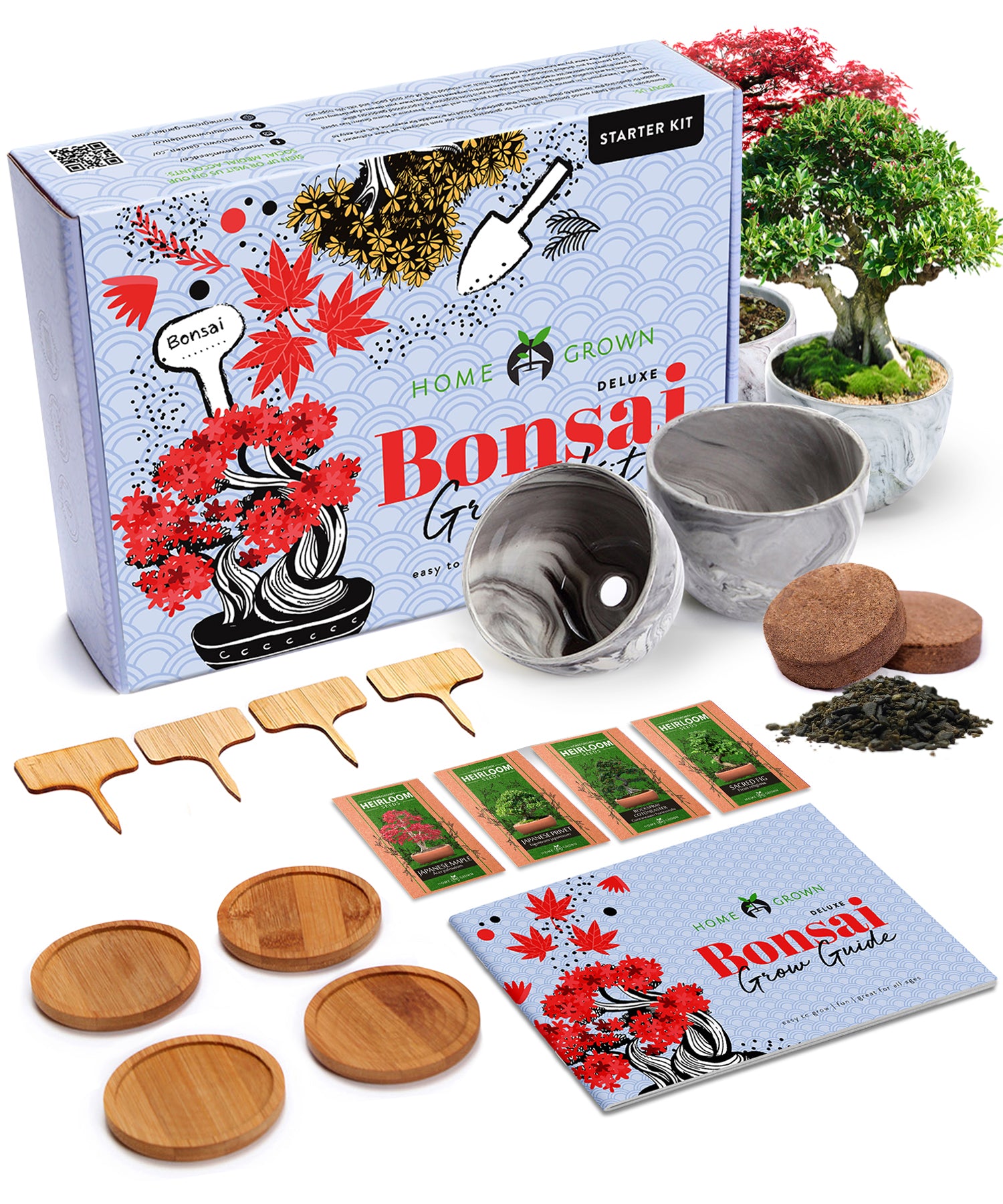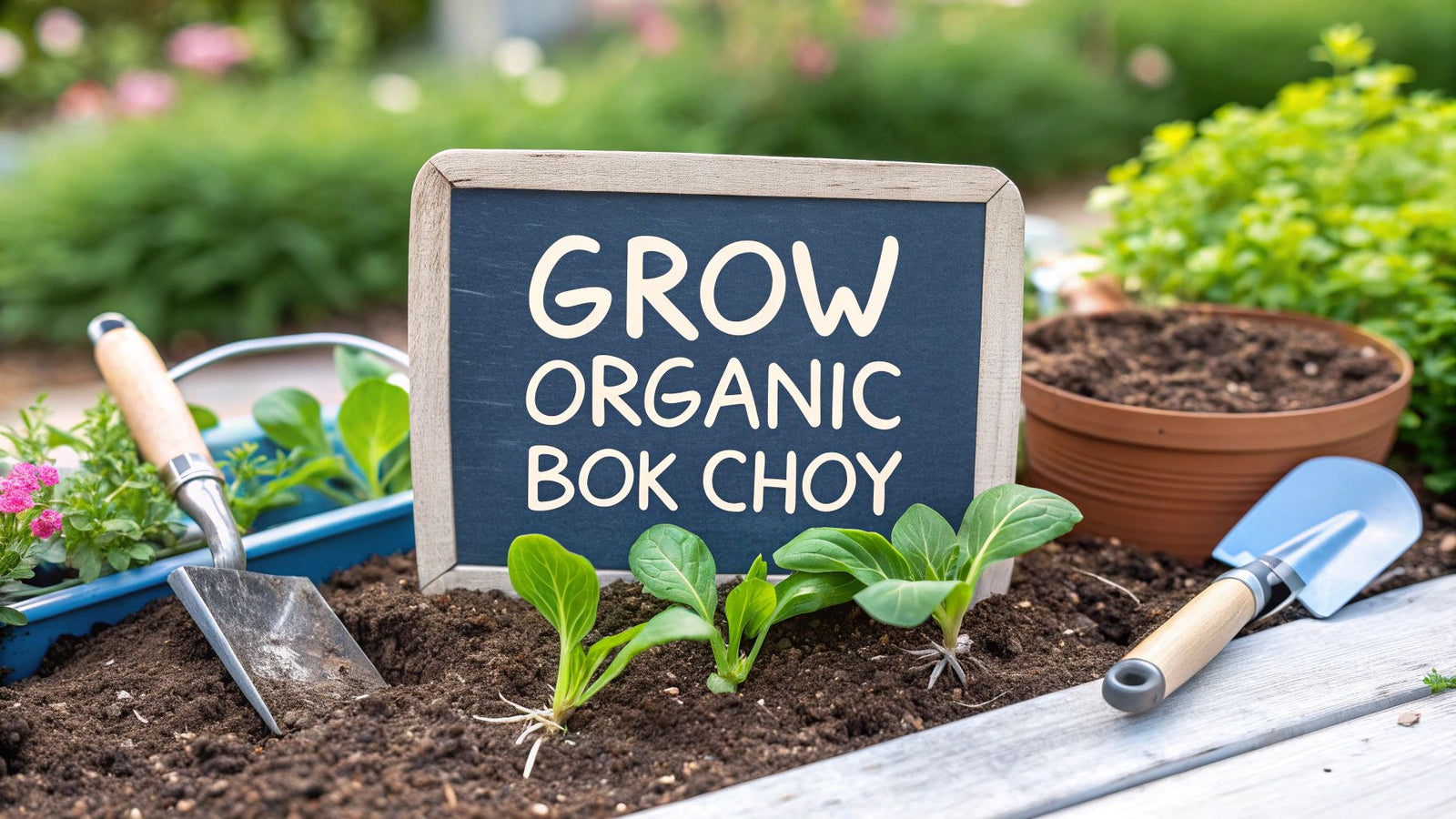
Choosing the right bok choy seeds organic is your first real step toward a crisp, delicious harvest right from your own garden. But real success isn't just about the seeds—it's about understanding the whole process, from picking the perfect variety for your space to knowing the exact moment to harvest those tender leaves.
Let's walk through it together.
Your 5-Step Guide to Growing Organic Bok Choy
Growing your own organic bok choy is one of those wonderfully rewarding projects that works for just about any gardener. It doesn't matter if you have a sprawling garden bed or just a few containers on the patio; you can absolutely succeed with this crop. This guide is your complete game plan, designed to give you confidence before you even tear open the seed packet.
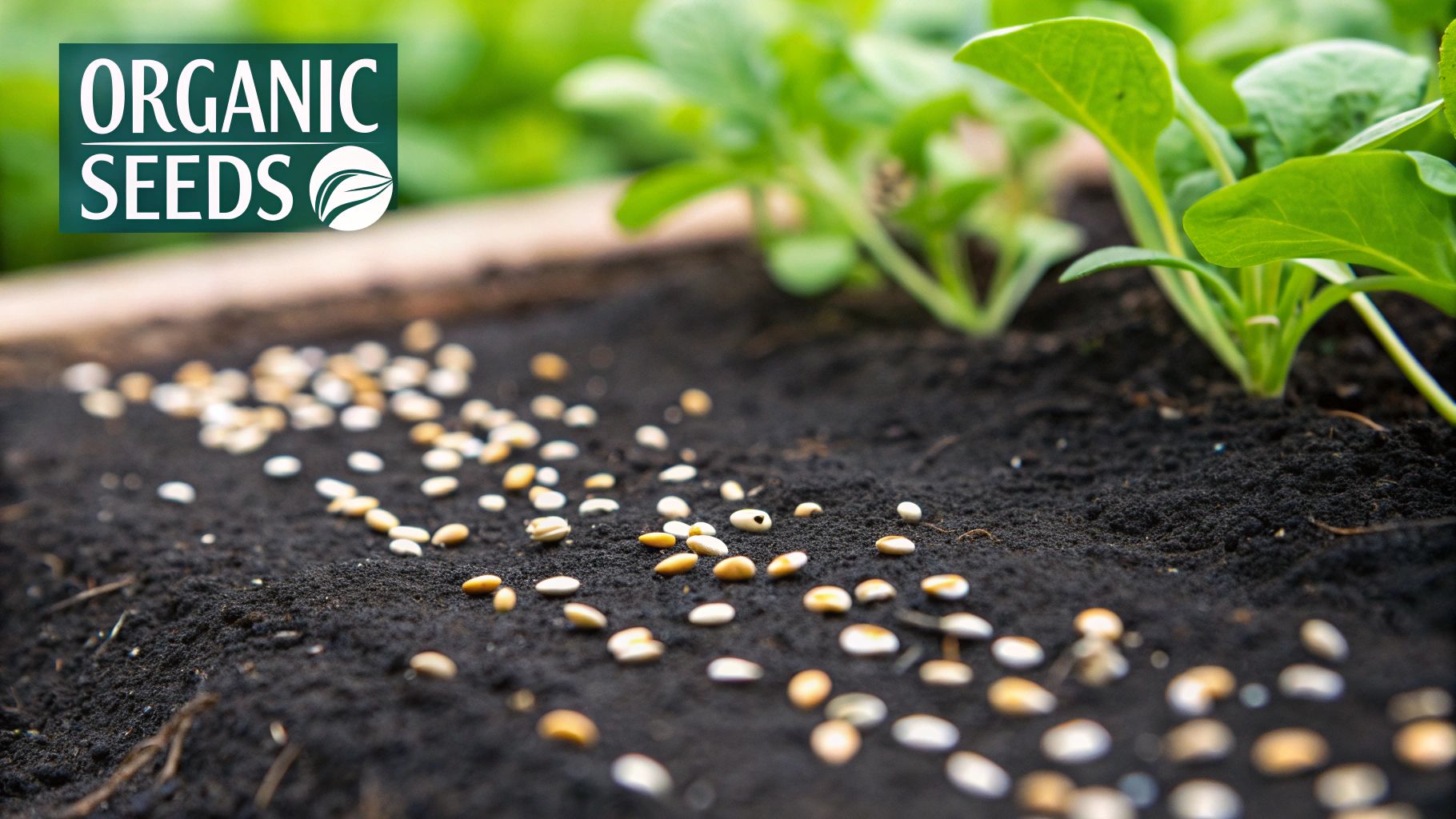
We'll get into the critical details that make all the difference, helping your plants thrive from the moment they sprout. This isn't just a list of instructions; it's about understanding why each step matters.
Here's a 4-step preview of what we'll cover:
- 1. Picking the Best Variety: Not all bok choy is created equal. I'll help you find a type that's a great match for your local climate, garden size, and what you actually like to eat.
- 2. Getting the Soil Right: Healthy plants start with healthy soil. You'll learn how to create a rich, well-draining foundation that your bok choy will love.
- 3. Nailing the Planting Process: From how deep to plant the seeds to how far apart to space them, getting these small details right prevents headaches like overcrowding later on.
- 4. Harvesting at the Perfect Time: Timing is everything. Snip your bok choy at its peak, and you'll be rewarded with the best possible flavor and texture.
5 Stages of Organic Bok Choy Growth At a Glance
To make things even easier, I've put together a quick-reference table that breaks down the entire journey. You can use it as a handy cheat sheet throughout the growing season.
Bok choy is a cool-season crop, truly at its best when temperatures are between 45°F and 75°F. This makes it a fantastic choice for both spring and fall gardens. In many climates, you can easily get two full harvests a year.
This table maps out the key phases, giving you a snapshot of what to do and when. Stick to these guidelines, and you'll be growing beautiful, healthy bok choy without any synthetic chemicals.
| Stage | Key Action | Pro Tip |
|---|---|---|
| 1. Seed Selection | Choose a certified organic variety suited to your climate (e.g., bolt-resistant for warmer areas). | "Baby" or "Toy" varieties mature faster and are perfect for container gardening or succession planting. |
| 2. Soil Preparation | Amend your garden bed or container with rich compost to ensure good drainage and fertility. | Aim for a soil pH between 6.0 and 7.0. A simple soil test can save you a lot of guesswork. |
| 3. Planting Seeds | Sow seeds approximately 1/4 inch deep, spacing them according to the variety's mature size. | Plant a new batch of seeds every two weeks for a continuous harvest all season long. |
| 4. Care & Maintenance | Provide consistent moisture (about 1-2 inches of water per week) and monitor for common pests. | Use floating row covers from day one to protect young plants from pests like flea beetles. It's a game-changer. |
| 5. Harvesting | Harvest outer leaves anytime or cut the entire head at the base once it reaches the desired size (about 45-60 days). | Always try to harvest in the morning. The leaves are crispest and most hydrated then, which makes for the best flavor and texture. |
Following this roadmap will help you cultivate a fantastic crop that's truly organic from the ground up.
7 of the Best Organic Bok Choy Seeds to Get in the Ground
Picking the right bok choy seeds organic is really where a great harvest begins. It’s easy to get bogged down by all the options out there, but I like to think of it as a menu. Each variety has its own personality, perfect for different gardens and different dishes. You don't just want any bok choy; you want the right one for your patch of dirt.
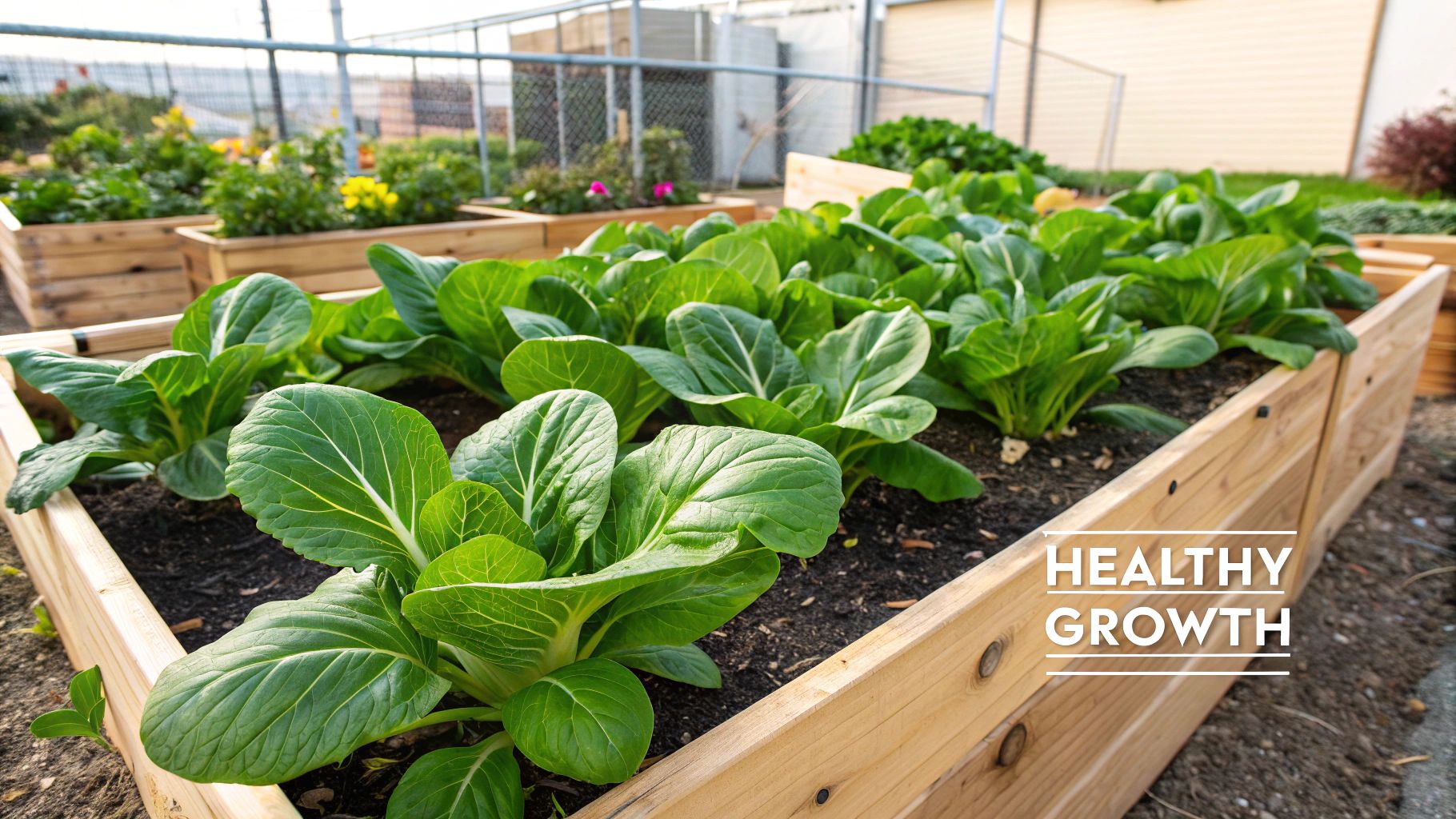
This boom in home gardening has really expanded the seed market. The global pakchoi (bok choy) seeds market, which includes a huge organic segment, was worth about USD 170 million back in 2022. As more people focus on health, that number is expected to hit around USD 250 million by 2028, growing at a solid 7.2% each year. You can learn more about the rising demand for bok choy seeds and produce worldwide if you're curious.
So, let's dig into seven fantastic organic varieties I've found to be reliable, delicious, and a great fit for the home gardener.
1. Toy Choy (Baby Bok Choy)
If you're working with a small space or planting in containers, Toy Choy will be your best friend. This is a classic baby bok choy, growing to a neat, compact 5-7 inches tall. It's also incredibly fast, often ready to pull from the soil in just 30-40 days.
- Best For: Container gardens, squeezing in multiple plantings (succession planting), and anyone who wants a quick harvest.
- Flavor Profile: It’s wonderfully mild and sweet. The white stems have a great crispness, and the dark green leaves are silky smooth.
- Growing Tip: Since it grows so fast, you can sow a new row every two weeks. This simple trick will give you a steady supply all through the cooler months.
2. Joi Choi Hybrid
For those of us gardening in warmer climates, bolting—when a plant flowers and goes to seed too early—can be a real headache. Joi Choi is the solution. This variety was specifically bred to resist bolting and handle heat, a rare trait for a brassica.
It’s a bit bigger, reaching up to 12 inches with thick, crunchy, pure white stems. Its resistance to bolting gives you a much longer window to get out there and harvest.
3. Shanghai Green Stem
This one is a real looker, with beautiful spoon-shaped leaves and vibrant light green stems. Unlike the stark white stems on many other types, Shanghai Green Stem has a more uniform color and a texture that’s a bit more delicate.
It's a mid-sized plant, usually ready in about 45-50 days. The flavor is mild and sweet, which makes it a fantastic all-rounder for everything from raw salads to stir-fries.
Pro Tip: Shanghai Green Stem is my go-to for "cut-and-come-again" harvesting. Just snip off the outer leaves whenever you need them, and the center of the plant will keep pushing out new growth. It’s a great way to extend your harvest.
4. Black Summer
Don't worry, the name is a bit misleading—this variety isn't actually black. It's a vigorous, open-pollinated type that’s known for its incredibly dark green leaves and strong garden performance. Gardeners love Black Summer because it grows so uniformly and holds well in the garden without splitting.
- Maturity: Hits full size in around 45 days.
- Size: Forms dense, upright heads that are perfect for a single serving.
- Key Trait: Its robust nature makes it a super reliable choice. You know what you're going to get.
5. Red Choi
Want to add a splash of color to your garden beds and your dinner plate? Red Choi is a stunner, with gorgeous reddish-purple leaves that contrast with its bright green stems. The color really pops in cooler weather, making it a beautiful addition to a fall garden.
But it's not just about looks. Red Choi has a slightly more complex, almost mustard-like flavor than its green cousins. That peppery note adds a wonderful depth to salads and sautés. It’s another quick one, usually maturing within 45 days.
6. Mei Qing Choi
Mei Qing Choi is a fantastic dwarf pak choi. It produces these lovely, compact heads with a pleasant pale green color running through both the stems and leaves. I’ve found it’s surprisingly tolerant of both heat and cold, which makes it a versatile grower you can plant across different seasons.
The texture is incredibly tender and the flavor is sweet and mild, never bitter. It’s an excellent choice for steaming whole or tossing into soups since it cooks up so quickly and evenly.
7. White Stem (Heirloom)
For a taste of tradition, you can't go wrong with the classic White Stem bok choy. This is an heirloom, the very variety most people picture: dark green, crinkly leaves on top of crisp, snow-white stalks. It grows into a pretty substantial head, often reaching 12-18 inches tall.
Because it's an heirloom, you can let a few plants go to seed and save them for next year's garden. It has that quintessential bok choy flavor—a perfect balance of mild sweetness with just a hint of earthy cabbage.
9 Steps to Prepare Your Soil for a Thriving Garden
A successful harvest of crisp, tender bok choy begins long before you plant your first seed. If you ask me, the real secret lies right under your feet—in the soil. Creating a rich, fertile foundation is the single most important thing you can do to ensure your bok choy seeds organic grow into strong, healthy plants.
Forget just digging a hole and hoping for the best. Let's walk through the nine essential steps to build the perfect soil environment from the ground up. Think of this as creating a garden bed that not only feeds your plants but also supports a thriving little ecosystem.
1. Start with a Soil Test
Before you add a single thing to your garden, you have to know what you’re working with. A simple soil test kit is your best friend here. It’ll tell you your soil's pH and which nutrients might be lacking. For bok choy, you're aiming for a slightly acidic to neutral pH, ideally between 6.0 and 7.0.
Knowing your pH is critical. If your soil is too acidic or alkaline, the plants can't absorb essential nutrients, no matter how much beautiful compost you pile on. This quick test takes all the guesswork out of the equation and starts you off on the right foot.
2. Boost with Rich Organic Matter
Next up is my favorite part: enriching the soil with plenty of organic material. For an organic garden, this is absolutely non-negotiable. Adding a generous layer of well-rotted compost or aged manure does two amazing things.
First, it provides a slow-release buffet of nutrients that your plants can access as they grow. Second, it dramatically improves the soil's structure, helping heavy clay soils drain better and sandy soils hold onto moisture. For a complete rundown, check out our guide on how to prepare your garden soil for any type of vegetable garden.
3. Loosen the Soil Deeply
Compacted soil is a major roadblock for healthy roots. Your goal is to loosen the top 8-12 inches of your garden bed. I'm a big fan of using a broadfork for this job. It aerates the soil beautifully without destroying its delicate structure, which is something that aggressive tilling can easily do.
When the soil is loose and friable, your bok choy's roots can spread out effortlessly to find water and nutrients. The result? Much more vigorous plants.
4. Create the Perfect Container Mix
Growing in pots? This is where you get to play soil scientist and have complete control. Whatever you do, don't just scoop soil out of your yard—it will compact into a brick in no time. Instead, create a custom blend for top-notch drainage and nutrition.
A recipe I swear by is:
- One part high-quality organic potting mix
- One part finished compost or worm castings
- One part perlite or coconut coir for aeration
This mix strikes the perfect balance of moisture retention, drainage, and nutrients that container-grown bok choy absolutely loves.
The infographic below shows just how simple the planting process becomes once your soil is perfectly prepped.
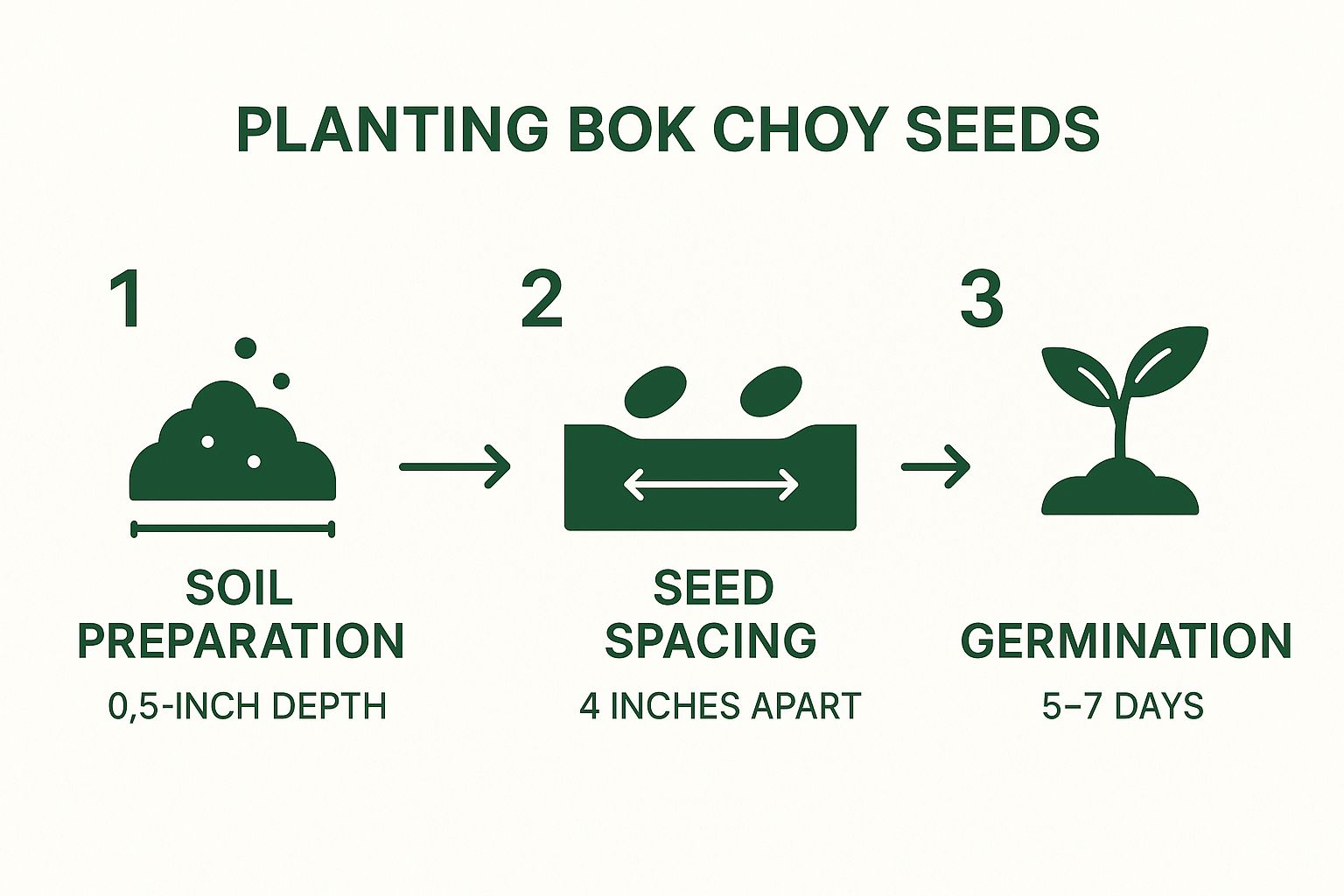
As you can see, once you've laid a healthy foundation for your seeds, the actual planting is a breeze.
5. Check for Proper Drainage
Bok choy needs consistent moisture, but it absolutely despises "wet feet." Poor drainage is a fast track to root rot and other nasty diseases. After preparing your bed, give the drainage a quick test. Dig a hole about a foot deep, fill it with water, and see what happens.
If the water is gone within a few hours, you're in great shape. If it’s still standing there the next day, you’ll need to work in more organic matter like compost to improve the soil structure.
6. Go Easy on Nitrogen
It’s tempting to load up on fertilizer, but with bok choy, less is often more—especially with nitrogen. While nitrogen does promote leafy growth, too much of it can make the leaves weak and floppy, basically sending out an open invitation to pests like aphids.
The compost you added earlier should provide plenty of balanced nutrition. If your plants do look like they need a little boost mid-season, a gentle organic liquid feed like compost tea is a much better choice.
One of the most common mistakes I see new organic gardeners make is over-fertilizing. Healthy soil biology, fueled by good compost, is far more effective at delivering balanced nutrition than any synthetic chemical.
7. Consider Raised Beds for Control
For those of us dealing with really tough native soil (I'm talking about heavy clay or rocky ground), raised beds are a fantastic solution. They let you control the soil composition completely, guarantee excellent drainage, and they have the added bonus of warming up faster in the spring.
8. Mulch Your Garden Bed
Once your bed is prepared and planted, apply a 2-3 inch layer of organic mulch. Things like straw, shredded leaves, or wood chips work perfectly. Mulching is such a simple step, but the benefits are huge: it helps retain soil moisture, keeps weeds down, and regulates the soil temperature.
9. Plan for the Future
Great soil isn't a one-and-done project; it's an ongoing relationship. As your plants grow, they draw nutrients from the soil. Get into the habit of adding a fresh layer of compost to your beds before each new planting season. This replenishes the soil and keeps it healthy and productive for years to come.
Before you even think about planting your bok choy, getting the soil right is crucial. For an even deeper dive, you can also consult this expert guide on preparing garden soil. This commitment to continuous improvement is what builds truly exceptional garden soil over time.
Alright, with your soil ready to go, it’s time for the best part—planting your bok choy seeds organic. This is where the magic really starts. Getting these first steps right lays the foundation for a garden full of healthy, robust plants.
Let's walk through the 5 key moments, from putting the seed in the ground to seeing that first little sprout.
1. Getting the Timing Just Right
Bok choy is a cool-season crop, which means timing is everything. It's happiest when temperatures hang out between 45°F and 75°F, making early spring and fall your best friends. If you plant too early in the spring, a late frost can zap your seedlings. Plant too late, and the summer heat will signal the plant to "bolt"—meaning it flowers prematurely, turning the leaves bitter.
Here's a pro tip: try succession planting. Instead of sowing all your seeds in one go, plant a small batch every two weeks. This simple trick staggers your harvest, so you get a steady supply of fresh bok choy instead of being buried in it all at once.
2. Depth and Spacing: Giving Your Plants Room to Breathe
How you place your seeds in the soil has a huge impact on their growth. Bok choy seeds are tiny, so they don't need to be buried deep at all. A shallow trench about 1/4 inch deep is perfect. Any deeper, and the little seedlings might run out of energy before they can reach the sunlight.
Spacing is just as important. When plants are too close, they have to fight for light, water, and nutrients, and the lack of airflow can invite diseases. I've found that giving standard bok choy varieties about 6 to 8 inches of space between each plant is the sweet spot. It gives each one plenty of room to fan out and grow into a full, healthy head.
3. Sowing Your Seeds: Indoors or Out?
You've got two solid options here. You can either sow your seeds directly in the garden bed or start them indoors in trays and transplant them later. The best choice really comes down to your local climate and personal preference.
- Direct Sowing: This is as straightforward as it gets. You just plant the seeds right where you want them to grow. If you have a long, mild spring or fall, this is a great, low-fuss method that avoids any transplant shock.
- Starting Indoors: If you're dealing with a short growing season or unpredictable spring weather (like I am!), starting seeds inside gives you a huge advantage. It provides a controlled environment, giving your seedlings a strong head start so they're ready to take off once you plant them outside.
Deciding whether to start seeds inside or sow directly can feel like a big choice, but both can lead to a great harvest. If you are new to indoor seed starting, our helpful tips for starting seeds indoors can guide you through setting up a simple, effective system at home.
4. The Right Way to Water for Germination
Once your seeds are in the ground, moisture becomes the name of the game. You want to keep the soil consistently damp—think of a well-wrung-out sponge—but definitely not soggy. Too much water can rot the seeds before they even have a chance to sprout, while letting the soil dry out completely can stop germination in its tracks.
I like to use a watering can with a gentle "rose" attachment or even just a simple spray bottle. A heavy stream of water can easily wash away those tiny seeds. A light, daily misting is usually all it takes until you see the first signs of life.
5. Watching for Those First Green Shoots
And now, we wait! This is always the most rewarding part for me. Within 5 to 10 days, you should see the first little green sprouts poking through the soil.
Healthy seedlings will have bright green cotyledons (their first two baby leaves) and look strong and upright. Once they develop their first set of "true leaves"—the ones that actually look like tiny bok choy leaves—it's time to thin them out to their final spacing. This little bit of sacrifice ensures the strongest seedlings get all the resources they need to thrive.
7 Smart Ways to Care for Your Growing Bok Choy
Once those first little green seedlings have pushed their way through the soil, your job description changes. You go from patient observer to active caregiver, and this is where the real fun begins. Consistent, thoughtful care is what will turn those fragile sprouts into the crisp, delicious heads of bok choy you're dreaming of.
Let's walk through seven organic strategies that will help you nurture your plants, keeping them healthy, productive, and downright delicious.
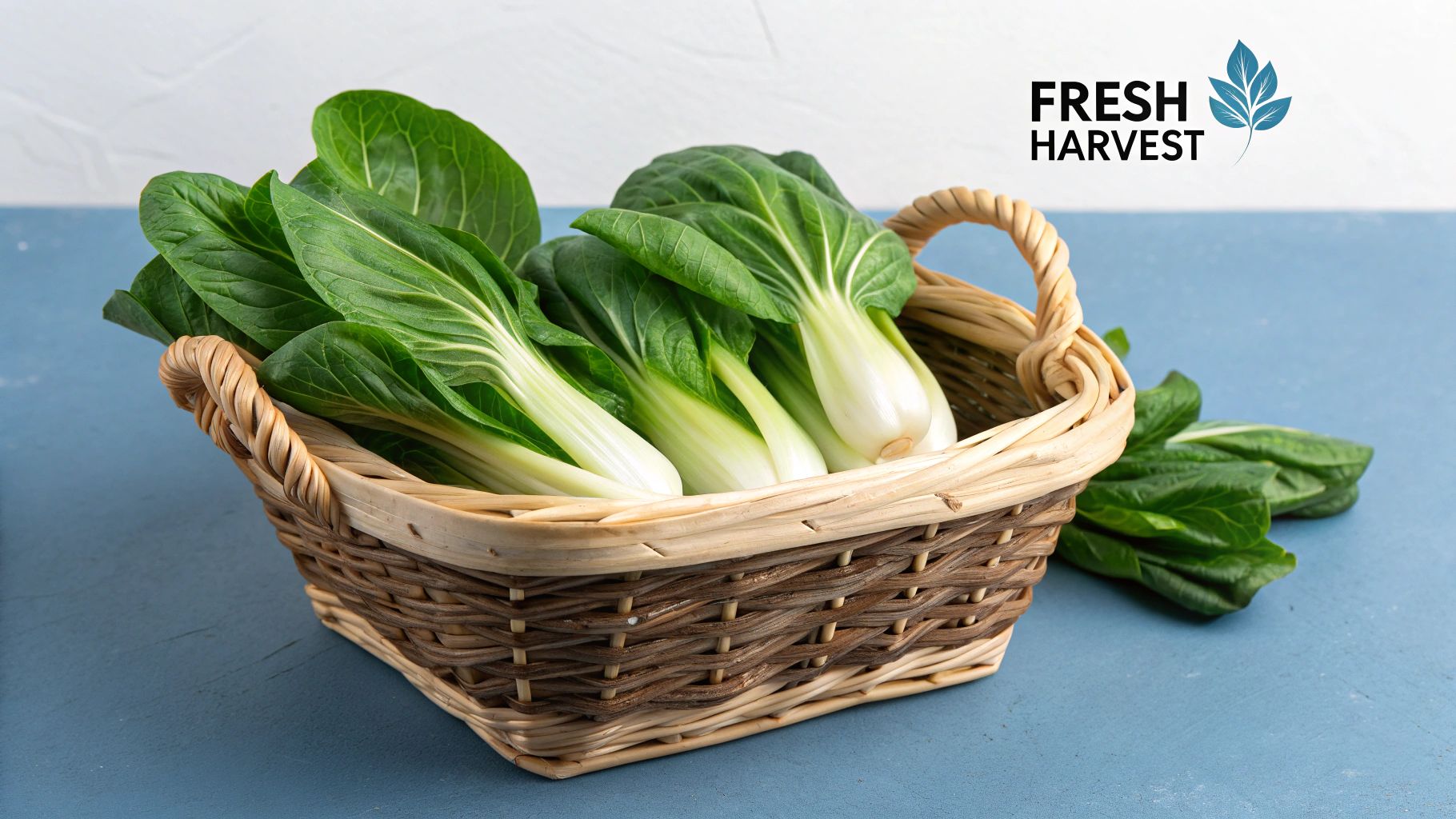
Everything we'll cover here is about working with nature, not against it. That means focusing on smart watering, gentle feeding, and proactive pest control that keeps your garden's ecosystem in balance and your harvest pure.
1. Master Consistent Watering
If there's one mistake I see new gardeners make with bok choy, it's inconsistent watering. This crop absolutely loves moisture, and letting it get too thirsty is the fastest way to trigger bolting (when the plant flowers prematurely). A light sprinkle here and there just won't do the trick; it only encourages a shallow, weak root system that can't handle even a brief dry spell.
Instead, your goal should be deep, thorough watering. Aim to give your plants about 1 to 2 inches of water per week. You want it to really soak down into the soil, encouraging those roots to grow deep and strong. The easiest way to check? Just stick your finger an inch or two into the soil. If it feels dry, it's time to water.
2. Provide a Mid-Season Nutrient Boost
While that rich compost you started with gives your bok choy a fantastic head start, these fast-growing greens are hungry plants. A little pick-me-up halfway through the season can make a huge difference in the size and quality of your final harvest. I always stick to gentle, organic options that feed the soil as much as they feed the plant.
Here are a couple of my go-to organic feeds:
- Compost Tea: Think of this as a probiotic drink for your garden. It's teeming with beneficial microbes that help your plants unlock and absorb nutrients already in the soil.
- Fish Emulsion: This is a classic organic fertilizer for a reason. It provides a nice, gentle dose of nitrogen that fuels lush, leafy growth. Just a heads-up—it has a pretty potent smell at first, but it fades quickly!
3. Use Physical Barriers Against Pests
In an organic garden, prevention is always your best defense. Pests like flea beetles (the ones that leave tiny "shotgun" holes in the leaves) and cabbage loopers can descend on your bok choy patch seemingly overnight. The most effective, chemical-free way to deal with them is to stop them from ever landing in the first place.
This is where a floating row cover becomes your best friend. I swear by these. It's a lightweight fabric that lets sunlight and water through but creates a physical barrier that keeps flying pests out. You just drape it over your plants from the day you sow or transplant, and it protects them through their most vulnerable stages. It’s a simple, one-and-done solution.
4. Practice Smart Companion Planting
Companion planting is an age-old technique that uses clever plant pairings to your advantage. It’s all about creating a diverse little ecosystem where plants help each other out by deterring pests and attracting beneficial insects.
A healthy garden is a diverse garden. By mixing in aromatic herbs and flowers, you're not just making it prettier; you're building a natural defense system that keeps pest populations in check without a single drop of spray.
Try planting aromatic herbs like mint, dill, or rosemary nearby. Their strong scents can confuse pests and mask the smell of your bok choy. Marigolds are another classic choice, especially for helping to repel nematodes in the soil.
5. Keep the Garden Bed Mulched and Tidy
A clean garden is a healthy garden. Applying a 2 to 3-inch layer of organic mulch—like straw, shredded leaves, or grass clippings—is one of the best things you can do. It locks in that crucial soil moisture, smothers out competing weeds, and helps keep the soil temperature cool and stable.
Just as important is keeping the area around your plants tidy. Make a habit of snapping off any yellowing or damaged lower leaves, especially if they're touching the soil. This simple bit of housekeeping improves air circulation right at the base of the plant, which is one of the best ways to prevent fungal diseases from getting a foothold.
6. Encourage Beneficial Insects
Remember, not all bugs are bad for your garden! You actually want to invite beneficial insects like ladybugs, lacewings, and tiny parasitic wasps to the party. These are the good guys—a personal pest control army that preys on common pests like aphids.
You can roll out the welcome mat for them by planting flowers they love. Alyssum, yarrow, and cosmos are fantastic choices. By providing a source of pollen and nectar, you give these helpful insects a reason to stick around and stand guard over your bok choy.
7. Apply Neem Oil for Targeted Control
Even with the best preventative measures, you might still run into a pest issue. If you spot aphids starting to cluster on the undersides of leaves, a targeted application of organic neem oil is an excellent line of defense. It works by disrupting the pest's life cycle, acting as an antifeedant and growth regulator, all without harming beneficial insects when you apply it correctly.
Always mix neem oil according to the package directions and spray in the early morning or late evening to avoid any risk of scorching the leaves in the hot sun. This thoughtful, measured approach is what organic gardening is all about.
It's a skill worth mastering, especially as the demand for bok choy seeds organic continues to soar. The global appetite for this versatile vegetable is undeniable. For instance, China, the world's top producer, harvested an estimated 125.65 billion kilograms in 2023. That’s a staggering 34.49% increase from the previous year, showing just how important this crop is in both local and international markets. You can learn more about the rising demand for bok choy seeds and produce worldwide.
Your Top 3 Questions About Organic Bok Choy Answered
Even the most seasoned gardeners run into a few head-scratchers now and then. When you're nurturing your bok choy seeds organic, questions are bound to pop up as you watch your little seedlings turn into lush, harvestable plants. Think of this as your go-to guide for troubleshooting the common hurdles.
We'll tackle the big ones: how much water is too much, why your plants are suddenly trying to flower, and who their best garden buddies are. Let's get you prepared to handle whatever your garden throws at you.
1. How Often Should I Water My Bok Choy?
This is the classic question, and the real answer is, "it depends." Forget a strict calendar schedule. The best way to know when to water is to listen to your soil. Bok choy loves soil that stays consistently moist, but it absolutely can't stand soggy, waterlogged feet.
The easiest trick in the book is the finger test. Stick your finger about an inch deep into the soil near your plants. If it feels dry, it's watering time. If you feel any moisture, you're good for now. This simple habit helps you avoid both underwatering (which stresses the plant) and overwatering (hello, root rot!).
Your goal should be to water deeply and less often, rather than giving your plants a quick, shallow sprinkle every day. This encourages the roots to dig deeper for moisture, building a stronger, more resilient plant that won't panic at the first sign of a dry spell.
As a general rule, aim for about 1 to 2 inches of water per week, whether that comes from rain or your hose. When you do water, aim for the base of the plant. Keeping the leaves dry is a simple way to fend off common fungal diseases.
2. Why Are My Bok Choy Plants Bolting?
It's one of the most frustrating things to see: your beautiful bok choy suddenly shoots up a flower stalk. This is called bolting, and it's the plant's panic button. Once it bolts, the plant pours all its energy into making seeds, which unfortunately turns the leaves bitter and tough.
So, what causes this stress response? A few things can trigger it:
- Too Much Heat: Bok choy is a cool-weather fan. When temperatures start consistently hitting above 75°F, the plant gets the signal that summer is coming and it's time to reproduce, fast.
- Water Stress: Inconsistent watering is a major culprit. Letting the soil dry out completely, even just once, can be enough to convince the plant its time is up.
- Longer Days: As the days stretch out in late spring, the extra hours of daylight can also tell the plant it's time to flower.
To keep bolting at bay, plant your seeds at the right time—early spring or fall is perfect. Keep that soil moisture nice and even, and consider adding a layer of mulch to help keep the soil cool. If you're in a warmer region, it's worth seeking out bolt-resistant varieties like 'Joi Choi' to give yourself a leg up.
3. What Are the Best Companion Plants for Organic Bok Choy?
Companion planting is like setting up a friendly neighborhood watch in your garden bed. It's a brilliant organic strategy where you pair plants that help each other out. The right neighbors can ward off pests, attract helpful bugs, and even give your bok choy a little growth boost.
It's all about creating a balanced little ecosystem. Some plants release strong smells that confuse pests like cabbage moths, while others are a magnet for beneficial predators like ladybugs who will chow down on any aphids they find.
Here are a few fantastic neighbors for your organic bok choy:
- Aromatic Herbs: Strong-smelling herbs like mint, dill, rosemary, and thyme are great for masking the scent of your bok choy. Pests will have a much harder time finding their target.
- Alliums: The whole onion family—onions, garlic, and chives—are well-known for repelling aphids and other common troublemakers.
- Beneficial Flowers: Marigolds are famous for deterring soil nematodes. Planting a little sweet alyssum nearby will attract hoverflies, and their larvae are absolute machines when it comes to eating aphids.
By making smart pairings, you're building a natural defense system that cuts down on the need for pest control. If you have more questions, our main frequently asked questions page is always available with more answers.
At Homegrown Garden, we believe a thriving garden is built on a foundation of quality seeds and solid know-how. Explore our full collection of heirloom and organic seeds, and let us help you grow the garden you've always wanted. Find everything you need at https://www.homegrown-garden.com.

